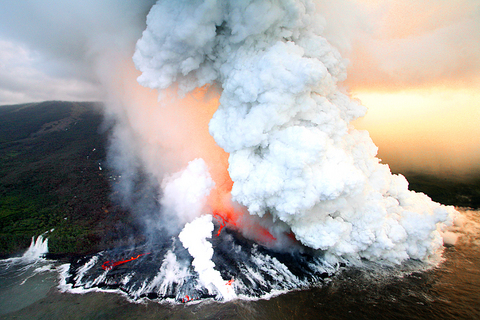Ten days after violently awakening, a volcano on the Indian Ocean island of Reunion continued spewing lava on Sunday in what experts called "the eruption of the century."
But the Piton de la Fournaise volcano on eastern Reunion had lulled considerably, and residents remained out of danger.
Tourists and residents have been able to take in the sights of the smouldering lava and magma being tossed as high as skyscrapers.

PHOTO: AFP
"We can call it the eruption of the century," said Zacharie Duputel, a seismologist based at the Volcano Observatory on Reunion island. "We have never observed such a phenomenon."
The eruption resulted in the collapse of the volcano's summit, with magma at times being spewed as high as 200m into the air.
The lava had cut off a national highway as it spurted toward the sea at 60kph, creating clouds of gas as it made contact with water. Sulphur dioxide levels in the gas have not been measured at dangerous levels.
Lava flow had been estimated at three million cubic meters per day.
On Sunday, lava leapt only 10m into the air, according to the observatory. There was less activity within the crater, though entire sections of rock continued to collapse.
Some people with memories of damage caused by previous eruptions were not enjoying the show. Eight houses were destroyed by lava in 1986.
About 100 residents were evacuated from a village in southeastern Reunion on Friday, with some believing they could see lava approaching.
They were allowed to return to their homes two hours later, however. What was believed to be lava turned out to be a forest fire caused by burning ashes.
About a dozen families have decided not to return to their homes anyway, said Guy Riviere, deputy mayor for the eastern city of Saint-Philippe and an agent for the Office of National Forests. He said they planned to return home after the volcano's activity reduced further.
While houses have not been affected, residents continue to hear loud rumbling in addition to seeing the burning forested area.
"The atmosphere is gloomy in the village," Riviere said.
About 300 hectares of primary forest has been destroyed over the past 10 days, and some 30 hectares of palm and vanilla plants have burnt. Timber used for cabinet-making that is not found elsewhere on the island was heavily damaged.

Shamans in Peru on Monday gathered for an annual New Year’s ritual where they made predictions for the year to come, including illness for US President Donald Trump and the downfall of Venezuelan President Nicolas Maduro. “The United States should prepare itself because Donald Trump will fall seriously ill,” Juan de Dios Garcia proclaimed as he gathered with other shamans on a beach in southern Lima, dressed in traditional Andean ponchos and headdresses, and sprinkling flowers on the sand. The shamans carried large posters of world leaders, over which they crossed swords and burned incense, some of which they stomped on. In this

‘NO COUNTRY BUMPKIN’: The judge rejected arguments that former prime minister Najib Razak was an unwitting victim, saying Najib took steps to protect his position Imprisoned former Malaysian prime minister Najib Razak was yesterday convicted, following a corruption trial tied to multibillion-dollar looting of the 1Malaysia Development Berhad (1MDB) state investment fund. The nation’s high court found Najib, 72, guilty on four counts of abuse of power and 21 charges of money laundering related to more than US$700 million channeled into his personal bank accounts from the 1MDB fund. Najib denied any wrongdoing, and maintained the funds were a political donation from Saudi Arabia and that he had been misled by rogue financiers led by businessman Low Taek Jho. Low, thought to be the scandal’s mastermind, remains

Near the entrance to the Panama Canal, a monument to China’s contributions to the interoceanic waterway was torn down on Saturday night by order of local authorities. The move comes as US President Donald Trump has made threats in the past few months to retake control of the canal, claiming Beijing has too much influence in its operations. In a surprising move that has been criticized by leaders in Panama and China, the mayor’s office of the locality of Arraijan ordered the demolition of the monument built in 2004 to symbolize friendship between the countries. The mayor’s office said in

FIGHTING CONTINUES: Thai military dropped 40 bombs on border areas, Cambodia said, while Bangkok said Phnom Penh launched heavy attacks and damaged homes Cambodia yesterday accused Thailand of intensifying its bombardment of disputed border areas, even as officials from the two countries attend a multi-day meeting aimed at negotiating an end to deadly clashes. The neighbors’ long-standing border conflict reignited this month, shattering an earlier truce and killing more than 40 people, according to official counts. About 1 million people have also been displaced. Cambodian and Thai officials were in their third day of talks at a border checkpoint, with ministers of defense from the two countries scheduled to meet today. However, the Cambodian Ministry of National Defense said Thailand’s military carried out a heavy